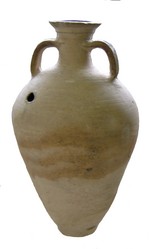Roman Amphorae: a digital resource
University of Southampton, 2005. (updated 2014) https://doi.org/10.5284/1028192. How to cite using this DOI
Data copyright © University of Southampton unless otherwise stated
This work is licensed under the ADS Terms of Use and Access.
Primary contact
Dr
David
Williams
Dept of Archaeology
University of Southampton
Avenue Campus
Highfield
Southampton
SO17 1BJ
England
Tel: 080 593032
Resource identifiers
- ADS Collection: 463
- DOI:https://doi.org/10.5284/1028192
- How to cite using this DOI
Gauloise 3

Courtesy of Musée Romain d'Avenches
David Williams
Distinctive FeaturesThis is an amphora with flat ringed base. The rim is made by turning the clay back on itself with a double external eversion; the upper part is rounded; a circle of relief is at the level of the upper attachment of the handles and the junction of neck and rim. The body is ovoid in shape and the handles have a central groove (Laubenheimer, 1985).Maximum height: 64.5 cm from examples from Gallia Narbonensis Maximum width: 35.5 cm from examples from Gallia Narbonensis Minimum rim diameter: 13,2 cm from an example at Sens Maximum rim diameter: 14 cm from examples from Gallia Narbonensis See characteristics | ||
Date RangeFirst century AD (Widemann et al., 1978).Search: [1st century AD] | ||
OriginA number of workshops are known in Gallia Narbonensis: Corneilhan (Hérault, Laubenheimer, 1985), Marseille (Bouches-du-Rhône: Bertucchi, 1992: Fig. 55(Bertucchi 7A)), Ponteilla (Pyrénées Orientales). It was also made outside this region at Chartres ( Eure-et-Loir, Sellès, 2001: 149-151), Noyon (Oise, Laubenheimer, 2003), Châlon-sur-Saône (Saône-et-Loire, Olmer, 1996), Sens (Yonne & Laubenheimer, 2003) and in the Bordeaux region (Berthault, 1992: Fig.2).Search: [France] [North West Europe] | ||
DistributionA regional distribution for this form produced outside Gallia Narbonensis (Remesal Rodríguez and Revilla, 1991). The Narbonnensian type has a distribution both within the region and outside, but the latter is sporadic.Search: [France] [North Africa] | ||
ContentsAmineum wine, from two tituli picti from Fos-sur-Mer (Laubenheimer, 2004: 163).Capacity: 29 to 30 litres for the Corneilhan type which is smaller than those found in Sens or at Châlon. Search: [Wine] | ||
CommentsPrincipal contributor: Fanette Laubenheimer | ||
ClassificationAugst 11Bertucchi 7A Peacock & Williams 29 | ||
CEIPAC linkThe following link will take you to the Centro para el Estudio de la Interdependencia Provincial en la Antiguedad Clásica CEIPAC database. In the CEIPAC system this amphora has the ID KE51+BYZ. Note: access to CEIPAC requires registration, which is possible via http://ceipac.ub.edu/corpus_reg.php?IDM=e | ||
Terres dâAmphoresTerres dâAmphoresThe above link will take you to the new digital database of amphora types and fabrics from Gaulish production centres, 1st - 3rd century A.D. (Maison Archéologie & Ethnologie, René-Ginouvès). | ||



 3D models
3D models


